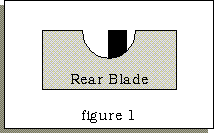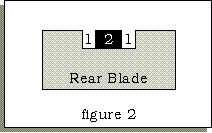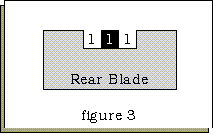| What about Sights? |
|---|
As a follow up on the shooting glasses tip, we are going to talk about the sights themselves that you are trying so hard to see. The most common type of "iron" sights, those required by international shooting rules, are the "partridge" type - a square rear notch and a square post front. There are other types - notably the "U" notch rear sight - used by some of the top European shooters. The "U" notch is interesting in that if you make a windage erroe in aligning the front sight with the rear, it shows up as a change in the height of the bar of light on the error side, as well as a change in the width of the light bar. See figure 1. I used this type of rear notch for several years when shooting Free Pistol, including when I set the National Record of 574.
 Many years ago some ingenious experiments were done to determine the optimum width of the front sight and the rear notch. Without describing the process, suffice it to say that the results led the experimenters to believe that a 3/16" (.187") width front post was best for 25 yard shooting, and a 1/10" (.100") width post was best for 50 yard shooting. This resulted in a compromise width of 1/8" (.125") that we find on many U.S. made pistols (High Standard, S&W 41, Ruger, Bomar, etc.). However, as shooters and equipment became better, and higher levels of performance were required to win important matches, sights were re-examined and new trials - by actually using them in cometition - resulted in the finding that for airgun shooting at 10 meters, a 4.5mm (.177") front post seemed best for most shooters, and 5mm was preferred for free pistol shooting at 50 meters. These sights are what is being shipped as standard on most guns being made at this time. But all makers offer other widths as options. Many shooters of mature years prefer front sights even wider: 5mm for airpistols for example. These sometimes are refered to as "old shooters" sights. There is a good reason for this: As the eyes ages, the efficiency of the rods and cones in the retina declines - making it more difficult to discern the boundries of the front sight and the rear notch. The wider sights "fire" more of these receptor cells and give the brain more information. The next question becomes the ratio of the front sight to the rear notch. This is often defined by comparing the width of the light bars on either side of the front sight when centered in the rear notch, to the width of the sight post itself. The most common ratios are "1:2:1" (see fig.2), and "1:1:1" (see fig. 3). I find the "1:2:1" to be best for me, but you should try to find what is best for you.

 Fortunately, the gun manufacturers are making this more easy by producing rear sights that can be adjusted for width of opening in near infinite increments over a pretty wide range. Just remember, it probably is unwise to go with light bars that are too narrow. The brain will be hard pressed to accurately distinguish just how wide each bar is as the number of receptor cells fired by a very narrow light bar are just too few to give reliable information. Jul05: addendum by BullsEye of www.MarkII.org Don |